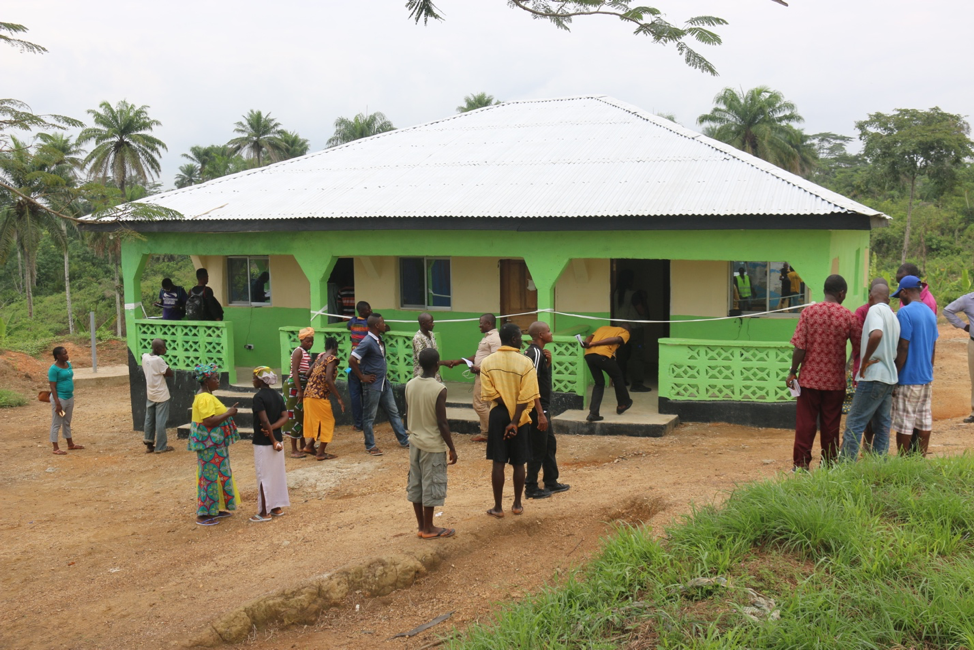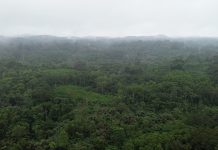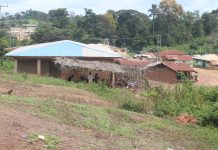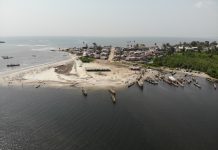Top: People gather for the dedication of a teachers’ lodge in Salayea, Lofa County that was built from forest resources in 2018. The DayLight/James Harding Giahyue
By Tarplah Toh and Emmanuel Sherman
MONROVIA – Towns and villages affected by logging concessions across Liberia have spent US$1.3 million and L$81,781,842.72 million on projects from the money they received from companies since 2015, according to a report launched on Wednesday.
In the last seven years, the communities have conducted a total of 53 projects, including guesthouses, clinics and schools from land rental fees companies paid them, said the report.
Fifteen schools, seven clinics, and 11 guesthouses are among the landmark projects in the report, which also features things like town halls, a rice mill, renovation of a community radio station and distribution of roofing sheets for vulnerable homes.
A clinic in Tiah Town, Nimba, a guesthouse in Zieh Town, Grand Gedeh and the rehabilitation of a road in Polar-Gboe Zammie, also in Grand Gedeh, is the most expensive of the projects. They cost over US$100,000, US$86,000 and US$79,000, respectively.
“Communities are the primary stakeholders in the forest regime, and they must benefit from whatever that is on land,” said Nora Bowier, chairperson of the National Benefit Sharing Trust Board (NBSTB), which oversees the expenditure of land-rental payments communities get from companies. The scheme is a major part of forestry reform meant to give villagers benefits from their forests.
Bowier made the comments at the launch of the report on Wednesday in Sinkor.
But the report pointed out that 17 projects were uncompleted, with one having already collapsed. The Trust Board said it would tackle the problem.
“We have already started taking steps towards addressing some of the unfinished projects,” Bowier said. “We have monitored these projects with action points and have submitted them to the community forest development committees (CFDCs) to work with their stakeholders to talk about the next issue,” Bowier adds. CFDCs are the leadership of communities that host logging concessions. There are 24 of them.
“We are going to look at areas where we can use the law to be able to hold the CFDC accountable.”
Bowier said there would have been more finished projects if the government had paid all the money logging companies paid for communities. Up to late last year, the government owed villagers US$5.5 million, according to Forest Trends, a U.S.-based NGO that advocates for sustainable logging and conservation worldwide.
Communities protested over the debt and later received US$200,000 a few months later. Recently, the government paid another US$401,000. However, it still owes the communities US$2.3 million against the allotment it made to communities in this year’s budget, with barely four months left in the fiscal period.
Generally, the government still owes communities some US$5 million.
“We request that the government pays whatever arrears it owes because some of the projects stalled due to the slow payment. We are asking them to pay on time and be consistent,” Bowier said in a phone interview with The DayLight. “We are actually engaging, constructive engagement.”
Andrew Zelemen of the National Union of Community Forest Development Committees (NUCFDC) said timely payment of forest benefits would empower villagers.





Facebook Comments